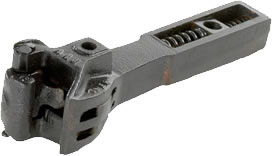The Janney Coupler, the earliest commercially successful version of the Knuckle Coupler, was a semi-automatic coupler patented by Eli H. Janney in 1873 (U.S. Patent 138,405).Prior to the formation of the AAR these were known as MCB Couplers (Master Car Builders Association).[2] In the United Kingdom, where it is fitted to some rolling stock, mostly for passenger trains, it is also known as a "Buckeye Coupler", possibly originating from the coupler's manufacture as early as 1890 by the Buckeye Steel Castings firm in Columbus, Ohio. The AAR/APTA Type E, Type F, and Type H tightlock couplers are all compatible Knuckle couplers, but are employed on specific types rail cars (general freight, tank cars, rotary hoppers, passenger, etc.).
Early knuckle couplers using a variety of proprietary head designs, but all using the most up to date MCB contour when cast, were the MCB; JANNEY (later version), TOWER, SHARON, CLIMAX, GOULD, BURNS, MILLER, and as many as 100 others.
After 1910 the MCB (Master Car Builders Association) reconstituted itself into the AAR (Association of American Railroads).
In 1913 ASF had developed the new Type "D" coupler that was accepted as the standard coupler for the USA, and no new equipment could be built using any other coupler. This standard design ended the market for couplers with a proprietary head design, which were common in the MCB days, to all but those exported from the USA to other countries not governed by the AAR standards.
 The Alliance coupler, named after the ASF-owned foundry in Alliance, Ohio, was developed as a lighter build than the AAR Type "D" coupler, and was marketed by the Amsted Corporation, the parent corporation of ASF, as the "Standard Coupler for the World". It was and is still the most used knuckle coupler in the world. The modern Alliance coupler still uses the modern AAR-10 and/or -10A contour, as well as others, but cannot be used in the USA on an "interchanging" railway.
The Alliance coupler, named after the ASF-owned foundry in Alliance, Ohio, was developed as a lighter build than the AAR Type "D" coupler, and was marketed by the Amsted Corporation, the parent corporation of ASF, as the "Standard Coupler for the World". It was and is still the most used knuckle coupler in the world. The modern Alliance coupler still uses the modern AAR-10 and/or -10A contour, as well as others, but cannot be used in the USA on an "interchanging" railway.
Brand names of the now standard AAR Type "E", "F" and "Tightlock" couplers are ASF, Buckeye (now known as Columbus Castings), and McConway & Torley.
The Interlocking contour of knuckle couplers was the first aspect to be standardized. In the MCB years, prior to about 1910, and as early as the first Janney in 1873, there were many proprietary "head" designs, and many MCB standard contours, which were constantly evolving and changing (as the approved standard contour for new couplers) every few years. In about 1910 the producers were all using the then standardized MCB-10 contour, soon to become the AAR-10. In the 1930s the AAR Type "D" was improved and became the Type "E"; the contour, however, stayed the same. A few years later the 10 contour was modified into a then optional standard called the 10A contour.
The most modern contour, for a plain Type "E" knuckle coupler, is still the AAR-10 and -10A, which are indistinguishable from the 1910 era MCB-10 contour. The same MCB-10 contour has been an approved standard for interchange service for over 100 years, with only the slightest dimensional changes.
The Type "H" "Tightlock" couplers, which are used on passenger-carrying rolling stock, also use slight revisions to the old 10A contour.
RMI knuckle couplers are made of either cast iron or cast steel and come in both 1.6" scale and 2.5" scale. The 1.6" coupler has built in draft gear, the 2.5" coupler may be ordered assembled with draft gear, or un-assembled with no springs or installed shaft.
|
|
|
|
|
|
|
|
|
|
|
|
|
|
|
|
Entire site © Copyright 2000-2021 RMI Railworks. All rights reserved. Nothing from this site may be copied or reproduced by any means without the express written permission of RMI Railworks. Some locomotives pictured here may include custom, builder-supplied features. RMI reserves the right to make improvements, pricing or specification changes at any time. For information Email: info@rmirailworks.com

